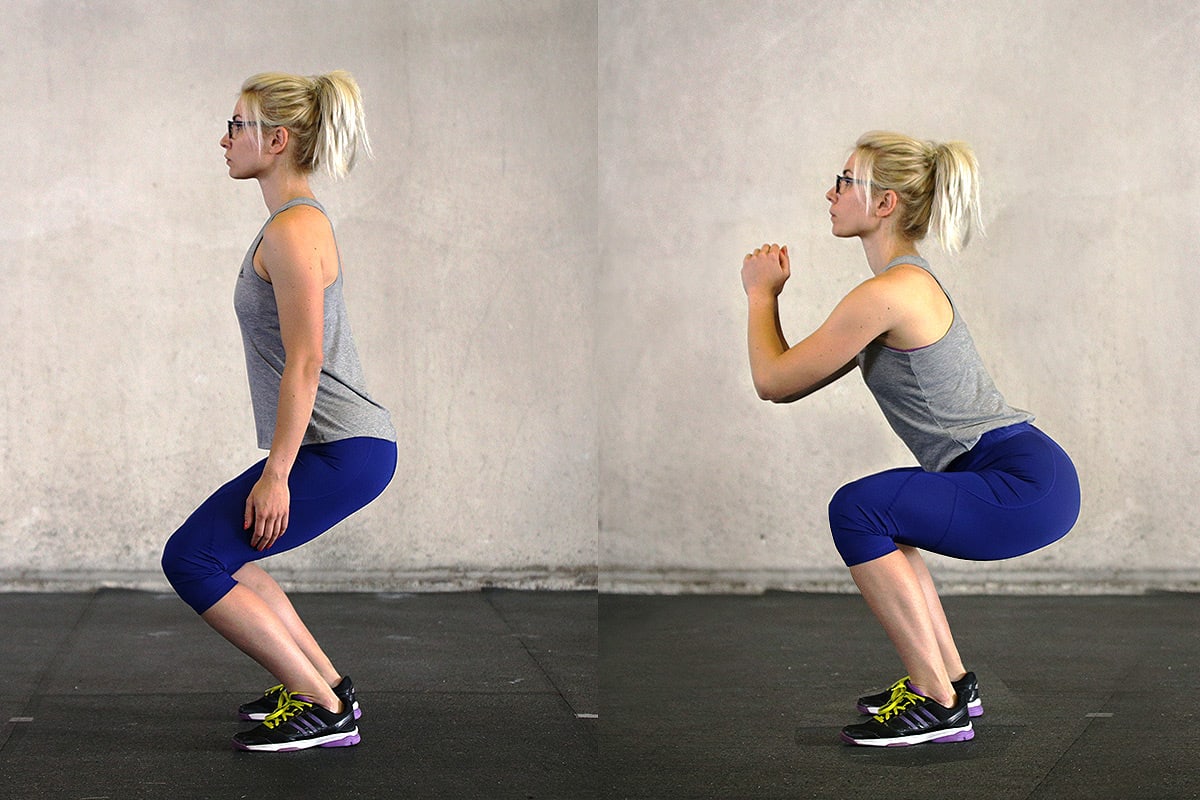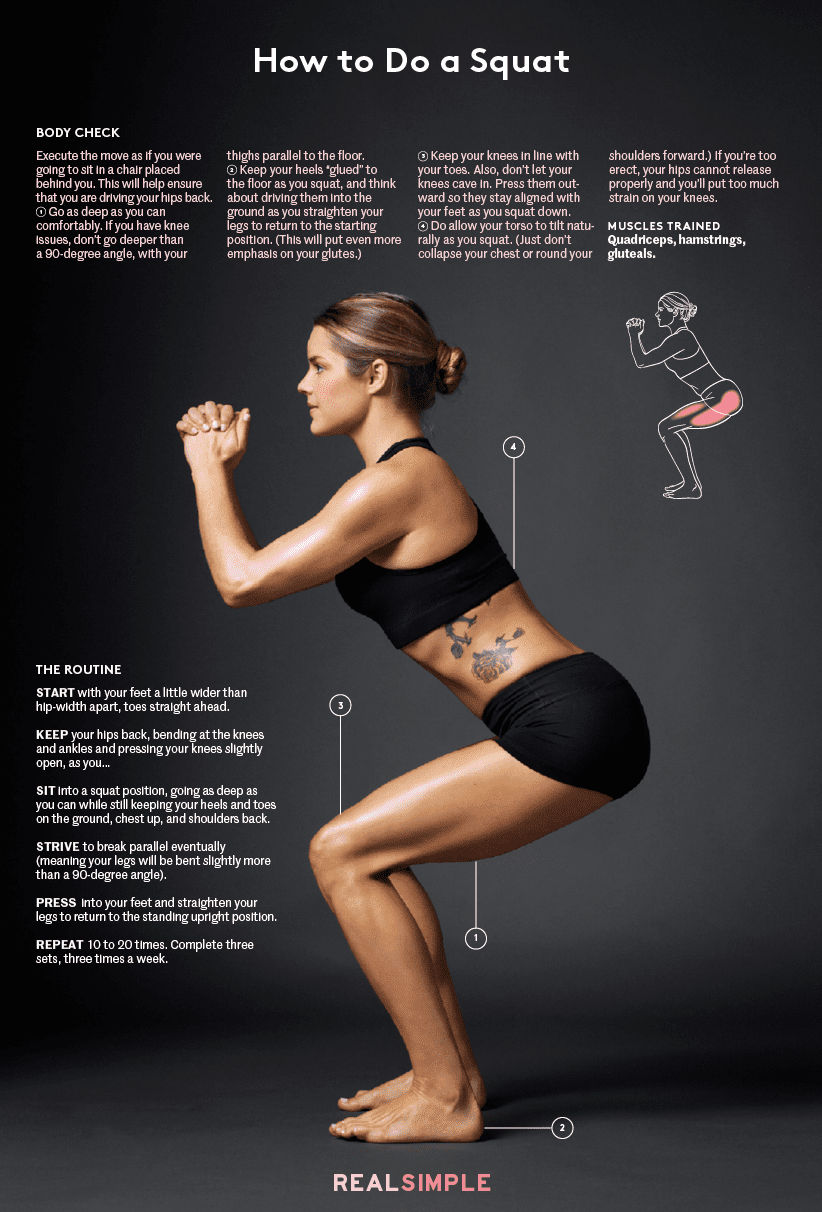Here’s How to Do Squats Properly, Safely, and Effectively Every Time
Not using proper squat form when you workout could be painful and even result in injury. Learn how to do squats the right way and reap all the benefits of this multifunctional move.

As babies, we must learn how to squat before we learn to stand or walk—and as adults, we have to rediscover how to squat properly. While this primal movement pattern is a base for many activities—like taking a seat and lifting heavy objects—learning how to do a proper squat from a fitness perspective sometimes requires a little coaching, especially to make sure you’re doing them safely and effectively.
Knowing how to do squats using your legs and not your back will translate into better workout performance and real-life functionality. Also among the benefits of squats is that they’re one of the most time-effective moves for shaping and strengthening your entire lower body, especially your backside. Since it engages all the major muscle groups of the lower body at once, you can actually squat your way to being an improved runner, tennis player, or dancer (as well as being able to move furniture without pulling something!)
The Basics: Proper Squat Form
1. Stand with feet a little wider than hip width, toes facing front.
2. Drive your hips back—bending at the knees and ankles and pressing your knees slightly open—as you…
3. Sit into a squat position while still keeping your heels and toes on the ground, chest up and shoulders back.
4. Strive to eventually reach parallel, meaning knees are bent to a 90-degree angle.
5. Press into your heels and straighten legs to return to a standing upright position.
The Details: How to Do a Squat Correctly Every Time, Step by Step
Step 1: Stand straight with feet hip-width apart.
Stand with your feet apart, slightly wider than your hips, and place your hands on your hips.
Step 2: Tighten your stomach muscles.
Standing up tall, gently pull your shoulders back, subtly lift your chest. On an exhale, try to pull your navel into your back to engage your deep abdominal muscles, which keep the spine and pelvis stable.
Step 3: Lower down, as if sitting in an invisible chair.
Bend your knees while keeping your upper body as straight as possible, as if you were lowering yourself onto a seat behind you. It is OK to allow your torso to tilt naturally as you squat, just don’t collapse your chest or round your shoulders forward. If you’re too erect, your hips cannot release properly and you’ll put too much strain on your knees.
Lower yourself as far as you can without leaning your upper body more than a few inches forward. Go as deep as you can comfortably. If you have knee issues, don’t go deeper than a 90-degree angle, with your thighs parallel to the floor.
Tip: Don’t allow your knees to go too far forward. You don’t want them to stick out past your toes—instead, try to keep them in line with your toes. Also, don’t let your knees cave inward. Press them outward (almost as if you were pushing out an invisible resistance band) so they stay aligned with your feet as you squat down.
Step 4: Straighten your legs to lift back up.
Straighten your legs, being careful not to lock your knees when you reach a standing position.
Tip: Keep your heels “glued” to the floor as you squat, and then think about driving them into the ground as you rise up to return to the starting position. This will put even more emphasis on your glutes.
Step 5: Repeat the movement.
Repeat for three sets of 10 to 15 reps.
Tip: Stretch your arms out in front of you for added balance during squats.
How Many Squats Should You Do a Day?
While doing squats daily probably won’t hurt you (unless you’re doing millions of them and/or holding heavy weights while squatting), a better goal beyond how many squats a day would be to aim to do three sets of 10–20 repetitions at least three times per week. This will give your lower-body muscles a good workout, and time in between to recover.
5 Major Benefits of Squats
1. They’ll Prime You to Lift Heavy Things Safely
Squats will not only prepare you to leap tall buildings as the Wonder Woman that you are, but they’ll give you the strength to pick up heavy objects correctly by using your lower body—instead of your back.
2. They’re Totally Time Efficient
One of the prime benefits of squats is that they’ll tone your booty quicker than just about any other move on the planet. By recruiting pretty much all the muscles in your lower body (quadripceps, hamstrings, gluteals), when you learn how to do a proper squat you’ll find yourself toning up faster and more effectively.
3. They Can Prevent Injuries
Most athletic injuries involve weak stabilizer muscles, ligaments and connective tissues, which squats help strengthen. Many people shy away from doing squats if they have knee issues, but studies have shown that the muscles recruited and built when a person does a proper squat will actually improve knee stability and strengthen the connective tissues surrounding the knee.
4. They Are Functional Fitness
Functional exercises are those that help your body to perform everyday activities more easily, as opposed to simply being able to operate pieces of gym equipment. Squats are one of the best functional exercises out there for promoting mobility, flexibility and balance with real-world benefits.
5. They Don’t Require Any Fancy Equipment
Yes, there are dozens of squat variations that can include different weights, resistance bands, exercise balls, and other equipment—but the good old-fashioned squat can be done pretty much anytime, anywhere. That means, if you’re not in the mood to walk 10 blocks to a workout class, or you’re staying at a hotel without a gym, you can still throw on a pair of sneakers and rock a few squat reps using only your body weight.
How Many Calories Do Squats Burn?
Quantifying caloric burn without every person reading this wearing a FitBit is impossible to calculate. This is because every body is different and factors like height, weight, fitness level, muscle/fat ratio, and so on all factor in to how many calories a person might burn doing any exercise.
This is really a case of quality over quantity being more effective. Because doing a proper squat simultaneously recruits so many muscles, it is a great bodyweight exercise for building muscle!
Instead of worrying about how many squats burn 100 calories, focus on how to do a proper squat and building more muscle, since for every pound of muscle you gain, your body will burn an additional 50-70 calories per day.
- By Kimberly Dawn Neumann
- By Maggie Seaver




